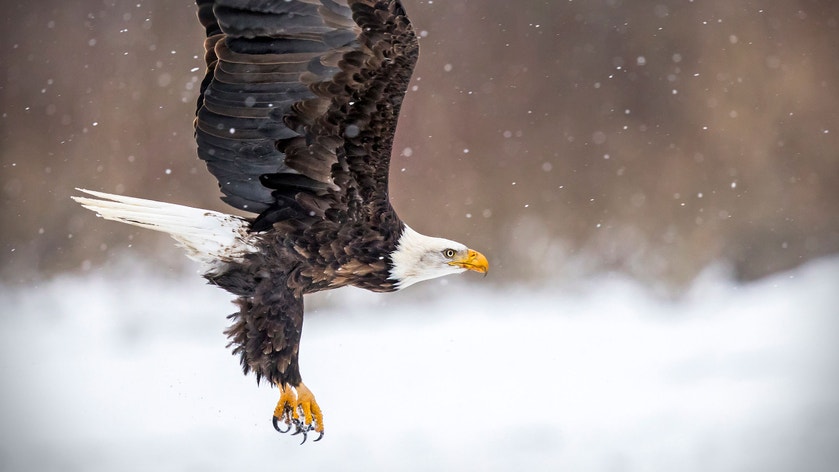Bald Eagle
At a Glance
The emblem bird of the United States, majestic in its appearance. It is not always so majestic in habits: it often feeds on carrion, including dead fish washed up on shore, and it steals food from Ospreys and other smaller birds. At other times, however, it is a powerful predator. Seriously declining during much of the 20th century, the Bald Eagle has made a comeback in many areas since the 1970s. Big concentrations can be found wintering along rivers or reservoirs in some areas.
All bird guide text and rangemaps adapted from Lives of North American Birds by Kenn Kaufman© 1996, used by permission of Houghton Mifflin Harcourt Publishing Company. All rights reserved.
Category
Hawk-like Birds, Hawks and Eagles
IUCN Status
Least Concern
Habitat
Coasts and Shorelines, Forests and Woodlands, Freshwater Wetlands, Lakes, Ponds, and Rivers, Landfills and Dumps, Saltwater Wetlands
Region
Alaska and The North, California, Eastern Canada, Florida, Great Lakes, Mid Atlantic, New England, Northwest, Plains, Rocky Mountains, Southeast, Southwest, Texas, Western Canada
Behavior
Direct Flight, Soaring
Population
200.000
Range & Identification
Migration & Range Maps
Many southern and coastal adults are permanent residents (as far north as Aleutian Islands). Birds from far northern interior migrate south in winter. Immatures from Florida may migrate far north (even to Canada) during their first summer.
Description
30-31" (76-79 cm). W. 6-7' 6 (1.8-2.3 m). Adults unmistakable with white head and tail, dark brown body. Immatures take four years to reach adult plumage; youngest juveniles have dark brown heads and bodies, some whitish mottling in wings and tail; older immatures may have much white on body.
Size
About the size of a Heron
Color
Black, Brown, White, Yellow
Wing Shape
Broad, Fingered, Long
Tail Shape
Rounded, Square-tipped, Wedge-shaped
Songs and Calls
Squeaky cackling and thin squeals.
Call Pattern
Falling, Flat, Simple
Call Type
Chirp/Chip, Scream, Whistle
Habitat
Coasts, rivers, large lakes; in migration, also mountains, open country. Typically close to water, also locally in open dry country. Occurs in a variety of waterside settings where prey is abundant, including swamps in Florida, edges of conifer forest in southeastern Alaska, treeless islands in Aleutians, desert rivers in Arizona. Also winters in some very dry western valleys.
Sign up for Audubon's newsletter to learn more about birds like the Bald Eagle
Behavior
Eggs
2, sometimes 1-3. White. Incubation is by both parents, 34-36 days.
Young
At least one parent remains with young almost constantly for first 2 weeks. Both parents bring prey to nest, tearing food into small pieces and feeding it directly to young at first; after 3-6 weeks, young begin pecking at food dropped in nest. In seasons when prey is scarce, only largest young may survive. Age at first flight about 10-12 weeks.
Feeding Behavior
Opportunistic; sometimes a predator, sometimes a scavenger. Does much hunting by watching from a high perch, then swooping down to catch prey in its talons. Also hunts by cruising very low over sea or land, taking prey by surprise. Where fish are abundant (as at spawning runs), may wade in shallow water to pursue them. Sometimes steals fish from Ospreys or other birds. Also lands on ground to feed on carrion.
Diet
Mostly fish when available, also birds, mammals. Feeds heavily on fish in many areas, including herring, salmon, carp, catfish, many others. When fish are scarce, may eat birds (ducks, coots, auklets, others) or mammals (jackrabbits, muskrats, others). Sometimes eats turtles, crabs, shellfish, other items. Often feeds on carrion; when fish or carrion readily available, may catch few birds or mammals.
Nesting
Usually first breeds at age 4-5 years, and may mate for life. Nest site is usually in tree, often on cliff in west, or on ground on northern islands. Tree nests are usually in very tall tree, standing above surrounding forest, up to 180' or more above ground. Nest (built by both sexes) usually a mound of sticks, lined with finer materials; nest may be reused and added to for years, becoming huge. Great Horned Owls sometimes take over nests.
Conservation
Conservation Status
Numbers declined seriously during the first two-thirds of the 20th century. Shooting was one major cause; even after the eagles were given full legal protection, they continued to decline, probably because of the effects of DDT and other persistent pesticides. Following the banning of DDT, numbers have been increasing gradually since the 1970s, with spectacular recoveries in some states.
Climate Threats Facing the Bald Eagle
Choose a temperature scenario below to see which threats will affect this species as warming increases. The same climate change-driven threats that put birds at risk will affect other wildlife and people, too.












